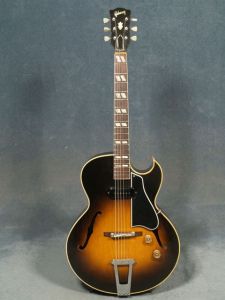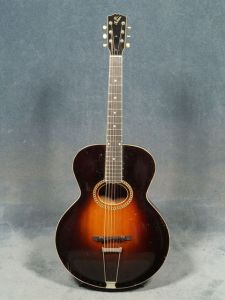I’m in the East Lansing with my wife for Thanksgiving, and I finally had a chance to go to Elderly Instruments. Of all the guitar store I’ve been to, I think this one was my favorite. I liked everything about it, from the outside of the building to the guitars and people who work in it. In fact, I liked the way it looked so much that I took a picture of the building.
However, what I liked the best is that they had a lot of interesting guitars there that I’ve never had the chance to play before. Since I was visiting the store, as opposed to just working on whatever guitars that needed a setup, I was seeking out guitars I thought would be exceptional. As a result, this post includes all the guitars I played.
Gibson ES-175 (1952). The link is to the Elderly page for this guitar, which may go bad after this guitar sells, so I’ll include the description and a picture.
VGC+, sunburst finish, double bound 16″ maple body, mahogany neck (screw hole in heel where strap button once was), bound rosewood fretboard, split parallelogram inlays, 20 frets, 1 P90 pickup, adjustable bridge (non-original top with nylon saddles, original in case), replacement trapeze tailpiece, newer b-w-b-w-b pickguard installed, headstock overlay features logo and crown inlays, replacement tuners with single ring keystone buttons (originals in case), great (BIG) sound, 1-11/16″ nut, 24-3/4″ scale, on consignment, with newer HSC (SN:A-9878)
I think this was the first archtop I’ve ever played. It had nickel-wound strings (because of the pickup) which I don’t like as much for fingerpicking, but this guitar played like a dream. I pretty much just fingerpicked on it, at first with my fingers but then with some picks from the store. It sounded sort of mellow and relatively quiet (unplugged), and I liked that a lot. I was picking lightly because I was in the middle of the main room, so there a good chance it actually sounds pretty big, like the description says. Plugging it in would have made it sound more jazzy, I bet, but there wasn’t an amp nearby. The nut looked like it might be original, considering how yellowed out it was (practically orange). The description on the website doesn’t mention it, but I’m pretty sure the strap button on the butt wasn’t original. Perhaps that’s understood from the fact the tailpiece is non-original. Awesome guitar.
Collings D1A Wide Nut (New). Collings’ website lists all the specs, but very quickly: this was a dreadnaught with mahogany back, sides and neck, Adriondack spruce top, and ebony fretboard. Like all high-end guitars, it was well-made and comfortable to play (I like wide nuts!), but I wasn’t all that impressed with it, probably because it’s a dreadnaught. I think dreadnaughts are kind of imbalanced in the way they sound. They bass is really loud, but not deep, and the highs are always too piercing. I think that’s what makes them so great for flatpicking, but I really dislike them for fingerpicking. Of course, Fahey played a Gibson/Recording King Ray Whitely, which has the same shape and depth as a dreadnaught but with slopped shoulders, and later he played a Martin dreadnaught. So it’s definitely possible to get good sounds out of Dreadnaughts, I just don’t know how (yet?). And again, I don’t mean to say that a guitar made by a company that literally everyone likes isn’t good. I just found it to not be my thing, and that’s probably only because it’s a dreadnaught.
Gibson L-3 (1927). Again, the link is from Elderly’s website, so I’ll include a picture and their description.
grand concert size 16″ body, largest of the L-3 variations, sunburst finish on arched spruce top with oval soundhole (center seam has been splined and is completely oversprayed), bound soundhole, single ring mosaic rosette, dark natural finish on maple sides and back is oversprayed and there are several repaired and replaced areas of binding, 11-1/2 fret mahogany neck, bound ebony fretboard, dot inlays, 20 frets, adjustable ebony bridge, original trapeze tailpiece (string anchor has been replated), pearl script logo on headstock, original 3-on-a-plate tuners with white plastic buttons, missing pickguard, ~1-3/4″ nut, 24-3/4″ scale, on consignment, with period HSC (green lining) (SN:74054)
This guitar was otherworldly. I don’t know if the L-3s what fall under the holy grail of Gibsons, but this guitar was made in 1927. It’s 87 years old, and it was in better shape than my Guild F-30, but forget its shape, it sounded like nothing else I’ve ever played. It was to the point where I’m not sure how to describe it even. I kind of want to say that the strings sounded like they might gut strings, even though I never played gut strings, and these definitely were acoustic’s strings. It just sounded really warm, had great bass and highs (it’s a grand orchestra) and was really comfortable and fun to play. It had a chunky mahogany V neck, maple back and sides, and spruce top. I’m not sure how it’s braced on the top, but I believe the back was carved and not laminated. Pretty cool guitar and I think it’s priced right at $2200.
You might notice two pins coming out of the bottom side of the fingerboard extension. I have no idea what those are, but I’m set to find out!
Gibson L-50 (1934). Another pre-war Gibson, except this one seems to have been through the wringer with all its scratches and nicks. The most noticeable one was the pick wear on the bass side, as evidenced in the picture, but not to worry – it was lacquered over. The overspray is important for maintaining the longevity of the neck, but I wonder if someone like Frank Ford would have tried to match the rest of the finish. That would have been a hell of a job though. Another thing I noticed was that the fretwork was kind of iffy on the fretboard extension. The frets just weren’t all the way in. They didn’t seem to pop in and out, but still. Anyway, it was a nice guitar with nice action, but didn’t pull me in, and I feel like $1200 for a pre-war Gibson isn’t a bad price to pay. Here’s a picture of it and Elderly’s description, in case the link dies:
double bound 16″ body, sunburst finish, spruce top, a few repaired top and back cracks, repaired side / back seams near end block, f-holes, maple back and sides, mahogany neck, Brazilian rosewood fretboard, dot markers, 19 frets, trapeze tailpiece, adjustable rosewood bridge, tortoise plastic pickguard, non-original 3-on-a-plate tuners installed, instrument completely oversprayed, nice workhorse, 1-3/4″ nut, 24-3/4″ nut, with newer HSC (SN:802-41)
I’m noticing that all these archtops have maple back and sides, and I wonder why. Contemporary (to these guitars) acoustics had mahogany and rosewood back and sides, so why maple? One reason can think of is that maple is/was cheaper than rosewood, and a bigger piece of wood is needed if one is going to carve the back, so it makes sense they’ll go with maple. I guess mahogany is more expensive than maple as well, but that still leaves the sides. Aren’t the sides on archtops the same thickness as on acoustics?
Santa Cruz OM (New). Santa Cruz again. Man, these guitars are something else. It’s hard to decide where to start with this guitar, since everything about it was awe inspiring, but I should start with the specs. Indian rosewood back and sides, Sitka spruce top, mahogany V neck with ebony board, and scalloped braces. The visual design of this guitar was very tasteful. SCGC seem to kind of dance the less is more line, with some features being very minimal, like the tiny pearl dot inlays and teardrop pickguard, and some being more intricate, like the rosette and binding on the top. Like other Santa Cruzes, I noticed that the top is a little thicker, but I had no way of taking meaningful measurements. It could also be that my mind is playing tricks on me, because a thicker top goes against everything I know about guitar tops and how these guitars sound. Ok, so playability and sound – holy mackerel! This is definitely the second best guitar I’ve ever played (ranked below the Santa Cruz prewar OM). It was incredibly well-balanced with thumping bass and detailed, but not harsh highs. It was definitely one of those guitars that made me keep wanting to play it and got me to play differently. I also noticed that I was picking louder than before (I try and be considerate in guitar stores), which I believe was a result of this guitar being awesome. The only thing I would have changed would be the action. It was a wee bit high at the nut and the saddle, probably the way it was set up in the factory, and was left like that so whoever buys it can decide if they like it like that or need it lowered. Lastly, the beautiful fret ends! This time I remembered to take a picture.

(Click it to see the fret ends more clearly)
Each fret end is just a perfect triangle. Here’s a link to Elderly’s page for this specific guitar I played. It has a bunch of pictures (and hopefully won’t go down when it’s sold). This guitar ranks second for the best guitar I’ve ever played. The first is the Santa Cruz pre war OM, and remember that the prewar was a few years old. This one will mature quite a bit after a few years of playing. Damn, I miss it already.




